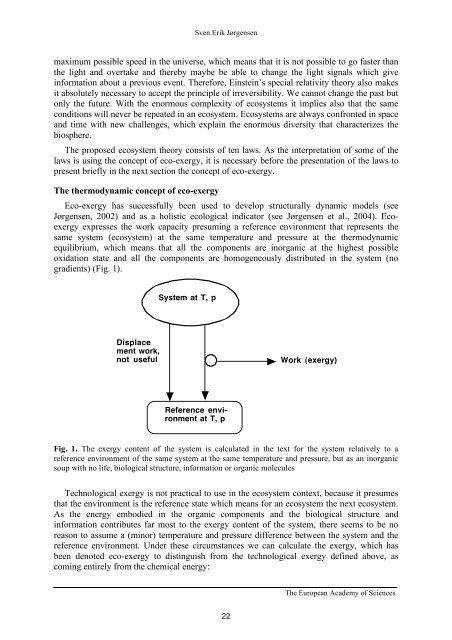An Integrated Ecosystem Theory - European Academy of Sciences
An Integrated Ecosystem Theory - European Academy of Sciences
An Integrated Ecosystem Theory - European Academy of Sciences
Create successful ePaper yourself
Turn your PDF publications into a flip-book with our unique Google optimized e-Paper software.
Sven Erik Jørgensen<br />
maximum possible speed in the universe, which means that it is not possible to go faster than<br />
the light and overtake and thereby maybe be able to change the light signals which give<br />
information about a previous event. Therefore, Einstein’s special relativity theory also makes<br />
it absolutely necessary to accept the principle <strong>of</strong> irreversibility. We cannot change the past but<br />
only the future. With the enormous complexity <strong>of</strong> ecosystems it implies also that the same<br />
conditions will never be repeated in an ecosystem. <strong>Ecosystem</strong>s are always confronted in space<br />
and time with new challenges, which explain the enormous diversity that characterizes the<br />
biosphere.<br />
The proposed ecosystem theory consists <strong>of</strong> ten laws. As the interpretation <strong>of</strong> some <strong>of</strong> the<br />
laws is using the concept <strong>of</strong> eco-exergy, it is necessary before the presentation <strong>of</strong> the laws to<br />
present briefly in the next section the concept <strong>of</strong> eco-exergy.<br />
The thermodynamic concept <strong>of</strong> eco-exergy<br />
Eco-exergy has successfully been used to develop structurally dynamic models (see<br />
Jørgensen, 2002) and as a holistic ecological indicator (see Jørgensen et al., 2004). Ecoexergy<br />
expresses the work capacity presuming a reference environment that represents the<br />
same system (ecosystem) at the same temperature and pressure at the thermodynamic<br />
equilibrium, which means that all the components are inorganic at the highest possible<br />
oxidation state and all the components are homogeneously distributed in the system (no<br />
gradients) (Fig. 1).<br />
System at T, p<br />
Displace<br />
ment work,<br />
not useful<br />
Work (exergy)<br />
Reference environment<br />
at T, p<br />
Fig. 1. The exergy content <strong>of</strong> the system is calculated in the text for the system relatively to a<br />
reference environment <strong>of</strong> the same system at the same temperature and pressure, but as an inorganic<br />
soup with no life, biological structure, information or organic molecules<br />
Technological exergy is not practical to use in the ecosystem context, because it presumes<br />
that the environment is the reference state which means for an ecosystem the next ecosystem.<br />
As the energy embodied in the organic components and the biological structure and<br />
information contributes far most to the exergy content <strong>of</strong> the system, there seems to be no<br />
reason to assume a (minor) temperature and pressure difference between the system and the<br />
reference environment. Under these circumstances we can calculate the exergy, which has<br />
been denoted eco-exergy to distinguish from the technological exergy defined above, as<br />
coming entirely from the chemical energy:<br />
The <strong>European</strong> <strong>Academy</strong> <strong>of</strong> <strong>Sciences</strong><br />
22


